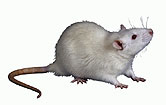
FRIDAY, March 30 (HealthDay News) — Cold conditions may affect the well-being of laboratory mice and influence the outcome of research studies, a new study suggests.
Researchers from the Stanford University School of Medicine found that nine of 10 drugs tested on mice that were housed in chilly temperatures failed to work in people. They suggested this may be because being cold triggers changes in mice’s immune function and slows their growth.
“If you want to design a drug that will help a patient in the hospital, you cannot reasonably do that in animals that are cold-stressed and are compensating with an elevated metabolic rate,” study author Joseph Garner, an associate professor of comparative medicine, said in a Stanford news release. “This will change all aspects of their physiology — such as how fast the liver breaks down a drug — which can’t help but increase the chance that a drug will behave differently in mice and in humans.”
The study authors argued that one simple way to correct this problem would be to allow laboratory mice to warm up, which would make them more physiologically comparable to people.
“Why not let them do what they do in the wild, which is build nests? Mice can happily infest a meat freezer, with temperatures far below zero, but they survive and breed because they build these wonderful nests,” Garner said.
To test their theory, the researchers created sets of two cages linked by a small tube for 36 male and 36 female mice of three common strains. In each of the sets, one cage was kept at a cool 68 degrees Fahrenheit and was equipped with various amounts of shredded paper that the mice could use to make nests to keep warm and provide themselves with shelter. The connected cage had no nesting material and was kept at one of six temperatures, ranging from 68 to 95 degrees Fahrenheit.
The mice were allowed to choose which side of the cage they wanted to use. Although the strain and sex of the mice played a role in their preferences, the study revealed none of the mice chose to stay cold. Instead, whenever they had the option the mice chose to move to a warmer cage.
The mice also moved nesting material from colder cages to warmer cages, suggesting nests serve as more than a source of warmth for mice. The researchers noted that nests could also be a source of physical comfort or protection for mice that relieves their stress or anxiety.
The study authors added that nests also offer clues about how the mice are doing physically. “The shape of the nest tells an experienced person whether the animals are too hot or too cold, whether they are sick or whether they are about to give birth,” Garner said. “Once you learn how to ‘speak mouse nest,’ the nest is a wonderful tool that anyone can use to assess the general state of the mouse.”
The study, published online March 30 in the journal PLoS ONE, pointed out that simply raising the temperature in research laboratories wouldn’t work because the mice would get too aggressive. The researchers concluded that laboratory mice should be routinely supplied with as much as 10 grams of nesting material.
More information
The U.S. National Cancer Institute provides more information on laboratory mice.

